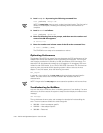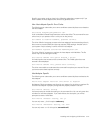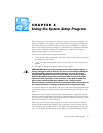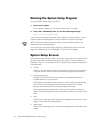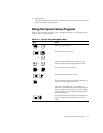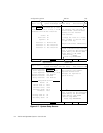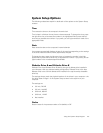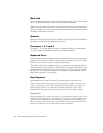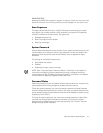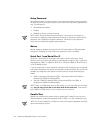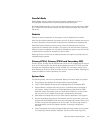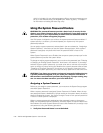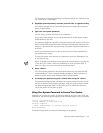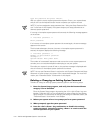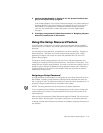
4-6 Dell PowerEdge 6300 Systems User’s Guide
1XP/RFN
Num Lock determines whether your system boots with the Num Lock mode activated
on 101- or 102-key keyboards (it does not apply to 84-key keyboards).
When Num Lock mode is activated, the rightmost bank of keys on your keyboard pro-
vides the mathematical and numeric functions shown at the tops of the keys. When
Num Lock mode is turned off, these keys provide cursor-control functions according to
the label on the bottom of each key.
6SHDNHU
Speaker determines whether the built-in speaker is On (the default) or Off. Rebooting
the system is required for the changes to take effect.
3URFHVVRUVDQG
Processors 1, 2, 3, and 4 display the version or stepping number of each processor
slot in the system. These options have no user-selectable settings.
.H\ERDUG(UURUV
Keyboard Errors
enables or disables reporting of keyboard errors during the power-on
self-test (POST), which is a series of tests that the system performs on the hardware
each time you turn on the system or press the reset button.
This option is useful when applied to self-starting servers or host systems that have
no permanently attached keyboard. In these situations, selecting
Do Not Report sup-
presses all error messages relating to the keyboard or to the keyboard controller
during POST. This option does not affect the operation of the keyboard itself if a
keyboard is attached to the computer.
%RRW6HTXHQFH
Boot Sequence
can be set to Diskette First (the default) or to Hard Disk Only.
The term
boot
refers to the system’s start-up procedure. When turned on, the
system “bootstraps” itself into an operational state by loading into memory a
small program, which in turn loads the necessary operating system. Boot
Sequence
tells the system where to look for the files that it needs to load.
'LVNHWWH)LUVW
Selecting Diskette First causes the system to try booting from drive A first. If the
system finds a diskette that is not bootable in the drive or finds a problem with
the drive itself, it displays an error message. If it does not find a diskette in the
drive, the system tries to boot from the CD-ROM, then from the hard-disk drive
(drive 0), and finally from the Plug and Play network adapters.



